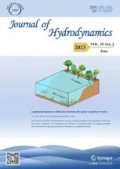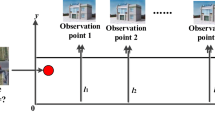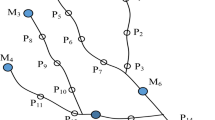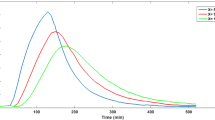Abstract
The pollution sources identification model is presented by the coupling of the river water quality model and particle swarm optimization (PSO) algorithm to estimate pollution sources from the measured/simulated contaminant concentration in the river. The “twin experiment” is adopted to verify the feasibility of the identification model, and three cases are constructed to explore the results of the identification model in different situations. The experiment test demonstrated that the identification model is effective and efficient, while the model can accurately figure out the quantities of the pollutants and position of a single pollution source or multiple sources, with the relative error of the mean is less than 3%. Many factors are explored, including the level of random disturbance and the impact of particle population size. The outcome showed that the disturbance level is less than 5%, thus the precision is preferable, and when the number of particles is three, the identification is the best. When performing multiple sources, identification of multiple sets of monitoring sections respectively can obtain more accurate results with less error. In this paper, the optimization method of the inverse problem is applied to the identification of river pollution sources, which can help us to identify pollution sources and provide us a scientific basis for subsequent water pollution control and prevention.
Similar content being viewed by others
References
Jiang D., Zhu H., Wang P. Inverse identification of pollution source release information for surface river chemical spills using a hybrid optimization model [J]. Journal of Environmental Management, 2021, 294: 113022.
Tang C., Yi Y., Yang Z. et al. Water pollution risk simulation and prediction in the main canal of the South-to-North Water Transfer Project [J]. Journal of Hydrology, 2014, 519: 2111–2120.
Huang B. S., Hong C. H., Du H. H. et al. Quantitative study of degradation coefficient of pollutant against the flow velocity [J]. Journal of Hydrodynamics, 2017, 29(1):118–123.
Hamdi A., Mahfoudhi I. Inverse source problem in a one dimensional evolution linear transport equation with spatially varying coefficients: Application to surface water pollution [J]. Inverse Problems in Science and Engineering, 2013, 21: 1007–1031.
Al-Jamal M. F. A backward problem for the time-fractional diffusion equation [J]. Mathematical Methods in Applied Science, 2017, 40(7): 2466–2474.
Wang L., Liu J. Data regularization for a backward time-fractional diffusion problem [J]. Computers and Mathematics with Application, 2012, 64(11): 3613–3626.
Wang J. G., Wei T., Zhou Y. B. Tikhonov regularization method for a backward problem for the time-fractional diffusion equation [J]. Applied Mathematical Modelling, 2013, 37(18–19): 8518–8532.
Tang H. W., Xin X. K., Dai W. H. et al. Parameter identification for modeling river network using a genetic algorithm [J]. Journal of Hydrodynamics, 2010, 22(2): 246–253.
Wei H., Chen W., Sun H. A coupled method for inverse source problem of spatial fractional anomalous diffusion equations [J]. Inverse Problems in Science and Engineering, 2010, 18(7): 945–956.
Yang X. J., Wang L. A modified Tikhonov regularization method [J]. Journal of Computational and Applied Mathematics, 2015, 288: 180–192.
Huai W., Yang L., Wang W. et al. Predicting the vertical low suspended sediment concentration in vegetated flow using a random displacement model [J]. Journal of Hydrology, 2019, 578: 124101.
Hund-Der Y., Chang T. H. Groundwater contaminant source identification by a hybrid heuristic approach [J]. Water Resources Research, 2007, 43: W09420.
Jha M., Datta B. Three-dimensional groundwater contamination source identification using adaptive simulated annealing [J]. Journal of Hydrologic Engineering, 2013, 18(3): 307–317.
Ayvaz M. T. A linked simulation-optimization model for solving the unknown groundwater pollution source identification problems [J]. Journal of Contaminant Hydrology, 2010, 117(1–4): 46–59.
Pan Q. K., Suganthan P. N., Tasgetiren M. F. et al. A self-adaptive global best harmony search algorithm for continuous optimization problems [J]. Applied Mathematics and Computation, 2010, 216(3): 830–848.
Srivastava D., Singh R. M. Breakthrough curves characterization and identification of an unknown pollution source in groundwater system using an artificial neural network (ANN) [J]. Environ Forensics, 2014, 15(2): 175–189.
Zeng L., Shi L., Zhang D. A sparse grid based Bayesian method for contaminant source identification [J]. Advances in Water Resources, 2012, 37: 1–9.
Wang H., Harrison K. W. Bayesian update method for contaminant source characterization in water distribution systems [J]. Journal of Water Resources Planning and Management, 2013, 139(1): 13–22.
Aurélien H., Jean-Francois G. Inverse transport problem of estimating point-like source using a Bayesian parametric method with MCMC [J]. Signal Processing, 2014, 96: 346–361.
Gzyl G., Zanini A., Fraczek R. Contaminant source and release history identification in groundwater: A multistep approach [J]. Journal of Contaminant Hydrology, 2014, 157: 59–72.
Yang H., Shao D., Liu B. Multi-point source identification of sudden water pollution accidents in surface waters based on differential evolution and Metropolis-Hastings-Markov Chain Monte Carlo [J]. Stochastic Environmental Research Risk Assessment, 2016, 30: 507–522.
Wei G. Z., Zhang C. Source identification of sudden contamination based on the parameter uncertainty analysis [J]. Journal of Hydroinformatics, 2016, 18(6): 919–920.
Liu X., Zhou Y., Hua Z. et al. Parameter identification of river water quality models using a genetic algorithm [J]. Water Science and Technology, 2014, 69(4): 687–693.
Zhang S. P., Xin X. K. Pollutant source identification model for water pollution incidents in small straight rivers based on genetic algorithm [J]. Applied Water Science, 2017, 7: 1955–1963.
Zhu Y., Chen Z., Asif Z. Identification of point source emission in river pollution incidents based on Bayesian inference and genetic algorithm: Inverse modeling, sensitivity, and uncertainty analysis [J]. Environmental Pollution, 2021, 285(8):117497.
Loukhaoukha K., Nabti M., Zebbiche K. A robust SVD-based image watermarking using a multi-objective particle swarm optimization [J]. Opto-Electronics Review, 2014, 22: 45–54.
Boubaker S. Identification of monthly municipal water demand system based on autoregressive integrated moving average model tuned by particle swarm optimization [J]. Journal of Hydroinformatics, 2017, 19(2): 261281.
Tan Y., Tan G. Z., Deng S. G. Hybrid particle swarm optimization with chaotic search for solving integer and mixed integer programming problems [J]. Journal of Central South University, 2014, 21(7): 2731–2742 (in Chiese).
Swathi B., Eldho T. I. Aquifer parameter and zonation structure estimation using meshless local Petrov-Galerkin method and particle swarm optimization [J]. Journal of Hydroinformatics, 2018, 20(2): 457–467.
Mategaonkar M., Eldho T. I., Kamat S. In-situ bioremediation of groundwater using a meshfree model and particle swarm optimization [J]. Journal of Hydroinformatics, 2018, 20(4): 886–897.
Acknowledgements
This work was supported by the Water Resources Department of Jiangsu Province (Grant No. 201641104), the Excellent Scientific and Technological Innovation Team in Jiangsu Province.
Author information
Authors and Affiliations
Corresponding author
Additional information
Projects supported by the National Natural Science Foundation of China (Grant No. U2040209, 51479064, 51739002 and 51979079).
Biography
Guang-han Zhang (1997-), Male, Master Candidate
Rights and permissions
About this article
Cite this article
Zhang, Gh., Liu, Xd., Wu, S. et al. Identification of pollution sources in river based on particle swarm optimization. J Hydrodyn 33, 1303–1315 (2021). https://doi.org/10.1007/s42241-021-0101-1
Received:
Revised:
Accepted:
Published:
Issue Date:
DOI: https://doi.org/10.1007/s42241-021-0101-1




